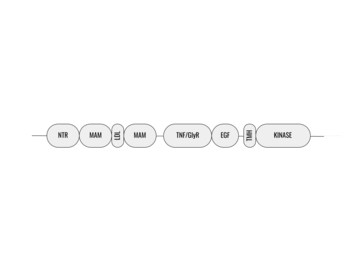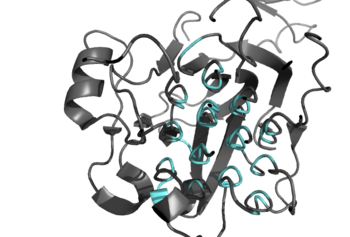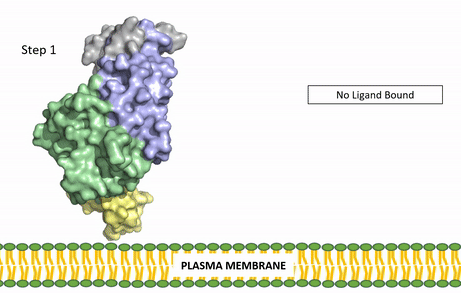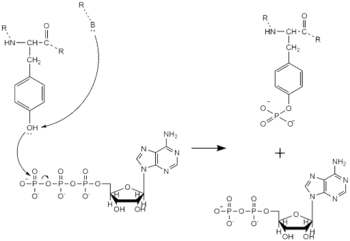Sandbox Reserved 1705
From Proteopedia
(Difference between revisions)
| Line 12: | Line 12: | ||
== General Structure == | == General Structure == | ||
[[Image:Ray_Traced_GlyR_Image.png|350 px|left|thumb|Figure 2: Shown in teal is the Glycine Rich Region of ALK in its helical structure. ]] | [[Image:Ray_Traced_GlyR_Image.png|350 px|left|thumb|Figure 2: Shown in teal is the Glycine Rich Region of ALK in its helical structure. ]] | ||
| - | Anaplastic lymphoma kinase is a <scene name='90/904310/Dimer/5'>homodimer</scene>, each <scene name='90/904310/Monomer_a/3'>monomer</scene> consisting of seven domains and two regions <ref name="Tongqing">PMID:34819665</ref>. These domains and regions are as follows: N-terminal region (NTR), two meprin–A-5 protein–receptor protein tyrosine phosphatase μ domains (MAM), low density lipoprotein receptor class A domain (LDL), <scene name='90/904310/Tnf_highlighted_monomer/5'>tumor necrosis factor receptor-like domain</scene> (TNF), <scene name='90/904310/Glyr_highlighted_monomer/5'>glycine rich region</scene> (GlyR), <scene name='90/904310/Egf_highlighted_monomer/3'>epidermal growth factor receptor-like domain</scene> (EGF), transmembrane α-helix (TMH), kinase domain <ref name="Reshetnyak">PMID:34819673</ref>. The NTR functions as a signal peptide, the structure of which is yet to be determined. Though the biological roles and structures of MAM and LDL have not been determined, they are a very unique component to ALK. ALK is the only RTK that has two MAM domains and a LDL domain. Studies of other MAM domains have suggested that MAM may play a role in cell-cell interactions through homophilic binding <ref name="Huang">PMID: 30400214</ref>. The TNF-like domain assists in mediating mature T-cell receptor induced apoptosis. Both the TNF domain and GlyR region are discontinuous, traversing each other frequently <ref name="Reshetnyak">PMID:34819673</ref>. The GlyR region consists of multiple glycine helices which is a highly unique structure. Though the function of ALK's EGF domain is unknown, we do know that all EGF domains are found in the extracellular region and are thought to be important building blocks for extracellular proteins <ref name=" | + | Anaplastic lymphoma kinase is a <scene name='90/904310/Dimer/5'>homodimer</scene>, each <scene name='90/904310/Monomer_a/3'>monomer</scene> consisting of seven domains and two regions <ref name="Tongqing">PMID:34819665</ref>. These domains and regions are as follows: N-terminal region (NTR), two meprin–A-5 protein–receptor protein tyrosine phosphatase μ domains (MAM), low density lipoprotein receptor class A domain (LDL), <scene name='90/904310/Tnf_highlighted_monomer/5'>tumor necrosis factor receptor-like domain</scene> (TNF), <scene name='90/904310/Glyr_highlighted_monomer/5'>glycine rich region</scene> (GlyR), <scene name='90/904310/Egf_highlighted_monomer/3'>epidermal growth factor receptor-like domain</scene> (EGF), transmembrane α-helix (TMH), kinase domain <ref name="Reshetnyak">PMID:34819673</ref>. The NTR functions as a signal peptide, the structure of which is yet to be determined. Though the biological roles and structures of MAM and LDL have not been determined, they are a very unique component to ALK. ALK is the only RTK that has two MAM domains and a LDL domain. Studies of other MAM domains have suggested that MAM may play a role in cell-cell interactions through homophilic binding <ref name="Huang">PMID: 30400214</ref>. The TNF-like domain assists in mediating mature T-cell receptor induced apoptosis. Both the TNF domain and GlyR region are discontinuous, traversing each other frequently <ref name="Reshetnyak">PMID:34819673</ref>. The GlyR region consists of multiple glycine helices which is a highly unique structure. Though the function of ALK's EGF domain is unknown, we do know that all EGF domains are found in the extracellular region and are thought to be important building blocks for extracellular proteins <ref name="Selander-Sunnerhagen">PMID:1527084</ref>. The TMH connects the extracellular and intracellular regions of ALK through the plasma membrane. The kinase domain is in the intracellular region and is phosphorylated at positions <scene name='90/904309/Tyrosines/1'>Y1278, Y1282, and Y1283</scene> through the tyrosine phosphorylation mechanism in order to begin signaling cascades <ref name="Selander-Sunnerhagen">PMID:1527084</ref>. The structures of the N-terminal region, MAM, and LDL have not been determined. Only the TNF, GlyR, and EGF portions of ALK are required for ligand binding. All portions of anaplastic lymphoma kinase are located in the extracellular domain except for the transmembrane α-helix which is in the transmembrane region and the kinase domain that is located in the intracellular region. |
| Line 27: | Line 27: | ||
| - | Dimerization of anaplastic lymphoma kinase activates the <scene name='90/904309/Kinase_domain/2'>kinase domain</scene> of each monomer <ref name="Li">PMID:34819665</ref>. Next, the kinase domains phosphorylate the [https://en.wikipedia.org/wiki/Tyrosine_phosphorylation tyrosine residues] (Y1278, Y1282, and Y1283 <ref name=" | + | Dimerization of anaplastic lymphoma kinase activates the <scene name='90/904309/Kinase_domain/2'>kinase domain</scene> of each monomer <ref name="Li">PMID:34819665</ref>. Next, the kinase domains phosphorylate the [https://en.wikipedia.org/wiki/Tyrosine_phosphorylation tyrosine residues] (Y1278, Y1282, and Y1283 <ref name="Hallberg">PMID:24060861</ref>) of the opposite monomer using ATP <ref name="Munck">PMID:34646012</ref>. These phosphorylated tyrosine residues recruit signal proteins through phosphorylation. These signal proteins begin a signaling cascade by utilizing various signal pathways including the ERK, JAK, and PI3K pathways. These pathways signal for cell proliferation and survival (ex: begin transcription). The mechanism of tyrosine phosphorylation is a key step in signal transduction and regulation of enzymatic activity. This mechanism is widely used with a variety of proteins and enzymes including being used in insulin signaling. If there is a problem with this mechanism, it can lead to many ill effects as the signaling pathways instigated by this mechanism will be unable to function correctly. |
Revision as of 00:33, 18 April 2022
| This Sandbox is Reserved from February 28 through September 1, 2022 for use in the course CH462 Biochemistry II taught by R. Jeremy Johnson at the Butler University, Indianapolis, USA. This reservation includes Sandbox Reserved 1700 through Sandbox Reserved 1729. |
To get started:
More help: Help:Editing |
| |||||||||||
References
- ↑ 1.0 1.1 1.2 1.3 Reshetnyak AV, Rossi P, Myasnikov AG, Sowaileh M, Mohanty J, Nourse A, Miller DJ, Lax I, Schlessinger J, Kalodimos CG. Mechanism for the activation of the anaplastic lymphoma kinase receptor. Nature. 2021 Dec;600(7887):153-157. doi: 10.1038/s41586-021-04140-8. Epub 2021, Nov 24. PMID:34819673 doi:http://dx.doi.org/10.1038/s41586-021-04140-8
- ↑ Palmer RH, Vernersson E, Grabbe C, Hallberg B. Anaplastic lymphoma kinase: signalling in development and disease. Biochem J. 2009 May 27;420(3):345-61. doi: 10.1042/BJ20090387. PMID:19459784 doi:http://dx.doi.org/10.1042/BJ20090387
- ↑ Li T, Stayrook SE, Tsutsui Y, Zhang J, Wang Y, Li H, Proffitt A, Krimmer SG, Ahmed M, Belliveau O, Walker IX, Mudumbi KC, Suzuki Y, Lax I, Alvarado D, Lemmon MA, Schlessinger J, Klein DE. Structural basis for ligand reception by anaplastic lymphoma kinase. Nature. 2021 Dec;600(7887):148-152. doi: 10.1038/s41586-021-04141-7. Epub 2021, Nov 24. PMID:34819665 doi:http://dx.doi.org/10.1038/s41586-021-04141-7
- ↑ Huang H. Anaplastic Lymphoma Kinase (ALK) Receptor Tyrosine Kinase: A Catalytic Receptor with Many Faces. Int J Mol Sci. 2018 Nov 2;19(11). pii: ijms19113448. doi: 10.3390/ijms19113448. PMID:30400214 doi:http://dx.doi.org/10.3390/ijms19113448
- ↑ 5.0 5.1 Selander-Sunnerhagen M, Ullner M, Persson E, Teleman O, Stenflo J, Drakenberg T. How an epidermal growth factor (EGF)-like domain binds calcium. High resolution NMR structure of the calcium form of the NH2-terminal EGF-like domain in coagulation factor X. J Biol Chem. 1992 Sep 25;267(27):19642-9. PMID:1527084
- ↑ 6.0 6.1 Li T, Stayrook SE, Tsutsui Y, Zhang J, Wang Y, Li H, Proffitt A, Krimmer SG, Ahmed M, Belliveau O, Walker IX, Mudumbi KC, Suzuki Y, Lax I, Alvarado D, Lemmon MA, Schlessinger J, Klein DE. Structural basis for ligand reception by anaplastic lymphoma kinase. Nature. 2021 Dec;600(7887):148-152. doi: 10.1038/s41586-021-04141-7. Epub 2021, Nov 24. PMID:34819665 doi:http://dx.doi.org/10.1038/s41586-021-04141-7
- ↑ 7.0 7.1 De Munck S, Provost M, Kurikawa M, Omori I, Mukohyama J, Felix J, Bloch Y, Abdel-Wahab O, Bazan JF, Yoshimi A, Savvides SN. Structural basis of cytokine-mediated activation of ALK family receptors. Nature. 2021 Oct 13. pii: 10.1038/s41586-021-03959-5. doi:, 10.1038/s41586-021-03959-5. PMID:34646012 doi:http://dx.doi.org/10.1038/s41586-021-03959-5
- ↑ Hallberg B, Palmer RH. Mechanistic insight into ALK receptor tyrosine kinase in human cancer biology. Nat Rev Cancer. 2013 Oct;13(10):685-700. doi: 10.1038/nrc3580. PMID:24060861 doi:http://dx.doi.org/10.1038/nrc3580
- ↑ Lewis RT, Bode CM, Choquette D, Potashman M, Romero K, Stellwagen JC, Teffera Y, Moore E, Whittington DA, Chen H, Epstein LF, Emkey R, Andrews PS, Yu V, Saffran DC, Xu M, Drew AE, Merkel P, Szilvassy S, Brake RL. The discovery and optimization of a novel class of potent, selective and orally bioavailable Anaplastic Lymphoma Kinase (ALK) Inhibitors with potential utility for the treatment of cancer. J Med Chem. 2012 Jun 26. PMID:22734674 doi:10.1021/jm3005866
- ↑ 10.0 10.1 Sahu A, Prabhash K, Noronha V, Joshi A, Desai S. Crizotinib: A comprehensive review. South Asian J Cancer. 2013 Apr;2(2):91-7. doi: 10.4103/2278-330X.110506. PMID:24455567 doi:http://dx.doi.org/10.4103/2278-330X.110506
- ↑ 11.0 11.1 Wang Q, Zorn JA, Kuriyan J. A structural atlas of kinases inhibited by clinically approved drugs. Methods Enzymol. 2014;548:23-67. doi: 10.1016/B978-0-12-397918-6.00002-1. PMID:25399641 doi:http://dx.doi.org/10.1016/B978-0-12-397918-6.00002-1
PDB Files Used
Student Contributors
- Kaylin Todor
- Rebekah White





